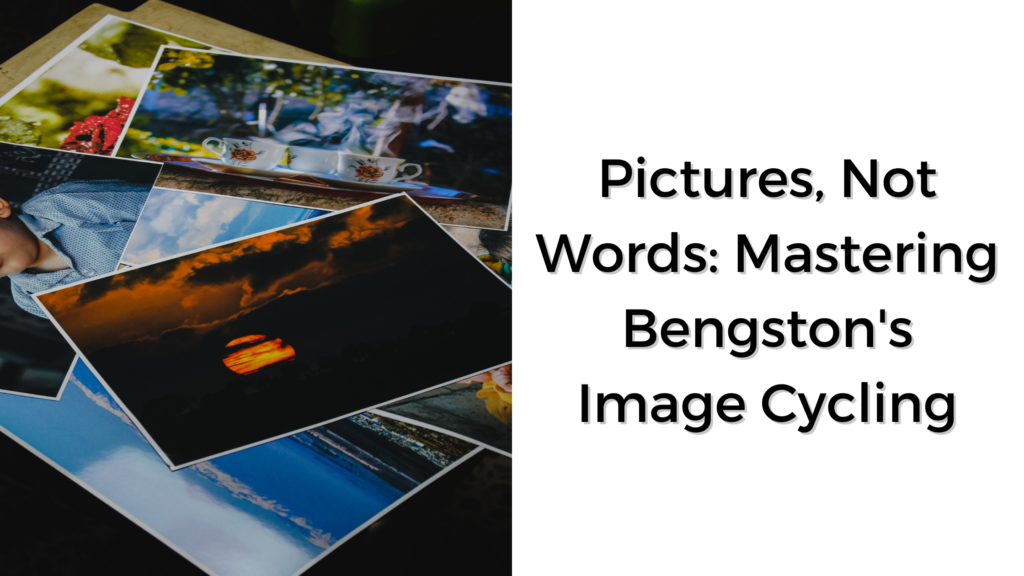Image Cycling Not Word Cycling
INTRODUCTION
Image Cycling, a cornerstone technique within the Bengston Method, involves creating vivid mental pictures, infusing them with emotions, and rapidly cycling through these images. This method, backed by extensive university-published research, has demonstrated remarkable results in facilitating complete cancer cures in mice. The research also highlights its potential applications in human cancer remission. Additionally, students report its effectiveness in manifesting and realizing desires.
You’ve been practicing diligently, but things aren’t shifting as you’d hoped. Perhaps your health issues persist, or your manifestation list remains unfulfilled. Don’t be discouraged. As a coach specializing in overcoming these challenges, I know this can happen for many reasons. This article will describe a small mistake some people make with Image Cycling—fixing it may unlock the results you’ve been hoping for.
When creating an Image Cycling list, practitioners often find it relatively straightforward to envision desired outcomes and infuse them with emotions. This often feels similar to typical visualization techniques. However, the challenge of memorization soon arises. In today’s digital age, where computers hold much of our memory, some of us may find it difficult to memorize complex images. A common shortcut is to memorize a word rather than the mental picture itself. When performing the “image image image” drill, where you rapidly cycle through your list of images, focusing on words instead of images can hinder the effectiveness of the technique. Words are helpful cues but should never replace the vivid mental image itself.

Philosophic Foundations of Manifestation
If you’re struggling with Image Cycling, it may help to step back and look at a broader context. Across cultures and centuries, humans have explored how thoughts and intentions turn into reality. Understanding these deeper philosophical foundations can help us see why focusing on images—not just words—makes a difference in manifestation. Let’s explore a few creation philosophies demonstrating how clear visualizing can powerfully impact the process.
Let’s briefly describe three creation schemas and see where images and abstract thinking fit.
Kabbalah’s Tree of Life

Western Hermeticism’s Kabbalah offers a rich philosophical framework for understanding the transformation of the immaterial into the material. It posits a hierarchical structure of ten sefirot, or divine emanations, descending from the Ein Sof, the infinite source. These sefirot represent various aspects of existence, from the most abstract to the most concrete. Through the interplay of these sefirot, the divine essence is gradually revealed and manifested in the material world. Kabbalah suggests that by understanding and aligning with this hierarchical structure, individuals can tap into the creative power of the universe and influence the manifestation of their desires.
According to Kabbalah, only the bottom sefirot, Malkuth, describes physical reality. Mental pictures are primarily associated with Yesod, while intellect and information processing begin with Hod and extend upward to Chokmah and Binah. This hierarchy demonstrates that abstract thinking resides higher on the Tree of Life than mental images. However, this doesn’t imply that the higher sefirot are superior tools for manifestation. They are part of the pathway, but skipping the mental picture step is like trying to bake a cake without mixing the ingredients first—you need every step to get the final result. Jumping ahead without focusing on the visual details can weaken the manifestation process.
Taoism
Taoism offers a profound understanding of the interconnectedness of all things and the power of our thoughts to shape reality. The principle “as above, so below” is central to this philosophy. Taoism teaches that we are not separate from the world but integral to it. Our actions and thoughts have ripple effects on the universe and vice versa.
According to Taoist philosophy, the universe is a unified whole, and our individual experiences (microcosm) reflect the larger universe (macrocosm). This means that our thoughts, which exist in the realm of the mind (above), can manifest into physical reality (below).
Taoist philosophy also describes manifestation as a series of transformations. Starting with the undifferentiated and non-dual Wu Qi, Oneness splits into Twoness, birthing polarity. The interplay of these polarities creates movement, leading to the formation of Yin/Yang. This bipolar world of duality sets the stage for the emergence of the Five Elements, which ultimately give rise to the 10,000 Things.

In Taoist philosophy, mental pictures belong to the realm of the 10,000 Things—the tangible outcomes of energy and intention. When you perform Image Cycling, you engage directly with this realm, using specific images to shape energy flow from the non-physical into the physical world. By focusing on clear mental pictures, you align your practice with these natural principles, allowing your intentions to manifest more smoothly.
Suzanne Clegg’s Octave Resonance Healing Approach™

If exploring Taoism and Kabbalah feels too abstract or complex, don’t worry—there’s a simpler way to grasp these ideas. My Octave Resonance Healing Approach™ provides a more straightforward framework for understanding the interconnectedness of reality and how it applies to your Image Cycling practice.
This approach is grounded in the understanding that the universe is composed of four interconnected levels: the physical, the life force, the emotions and images, and higher awareness. While each level is distinct and operates in its own way, they are also interconnected, forming a resonant system. Working with one level inevitably affects the others. For example, influencing the Octave of Higher Awareness will inevitably impact the Octave of Life Force. By adopting this four-fold perspective, we can navigate the non-physical realms more effectively and achieve our desired outcomes.
Three of the four levels pertain to the non-physical. Mental pictures belong to the Octave of Emotions and Images, while thoughts about the same are in the Octave of Higher Awareness.
To delve deeper into the Octave Resonance Healing Approach™ with examples and practical applications, please visit my website: https://spiritgate.com/octave-resonance-healing
Watch the video where I explain in detail:
How Can a Creation Story Help You Do Bengston’s “Image Image Image” Drill Better?
The point of this article is not to get you to embrace Taoism, Hermeticism, or even my Octave Resonance Healing Approach™. Rather, it’s to show you there may be a method to this complex yet rewarding process of manifestation. A system. A perspective that helps you appreciate the intricate details of an image that differ from the subtleties of a thought or idea. Your understanding of how manifestation works is important. For centuries, creation stories have inspired people to work with the unseen in a way that affects the physical.
The Bengston Method is one of the most detached and powerful forms of energy work I know, but I don’t think an abstract symbol or word pointing to what you want is better than a mental picture of it. An image is a mental picture of something. It’s not a feeling or thought about it. Bengston’s Image Cycling exercise is neither a word cycling exercise nor a thought or emotion cycling exercise.
Trust the power of the method. Stick with the images—after all, it’s called Image Cycling for a reason! Following this well-researched form will keep you on track to unlock its full potential.
If you’re struggling to achieve your desired results with the Bengston Method, I can help. Schedule a complimentary Get Acquainted Call to discuss your challenges and explore potential solutions.


That was great, Suzanne. Thank you! I really appreciated getting to both read your ideas and then hearing you in the video. Great explanation of Octave Resonance approach. I hope to share more when more things have come off my list!!
Thanks Suzanne, this explains why little has happened for me yet. I have been using images but mostly calling them up by words or pointing to my own body. I’ll find images and memorize them. Thanks again, very much!
Thanks a lot🙏
Very well done, Suzanne. The video adds great to the depth of the blog. I enjoyed both. I know because of “laziness” on my part, I sometimes catch myself going into just cycling words and not taking the time to do it correctly. I know in the sessions that you have helped me not only create images but play around with them, it has given me a new prospective on my list. For that I am very grateful. Thank you for your insight and helping me on my journey.